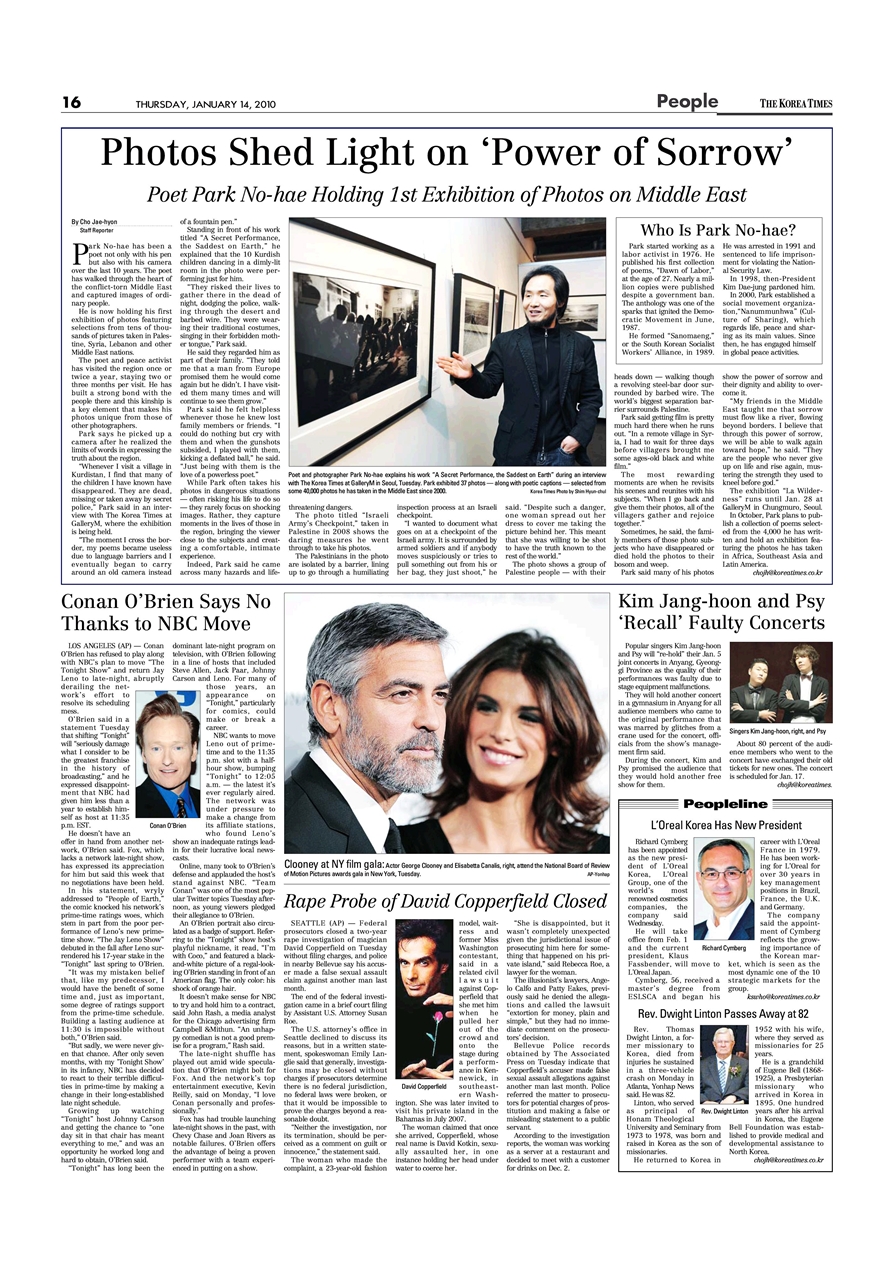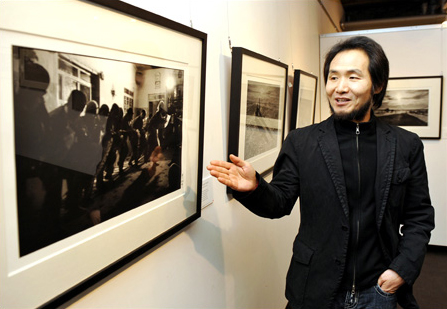
Poet Park No-hae Holding 1st Exhibition of Photos on Middle East

Poet and photographer Park No-hae explains his work “A Secret Performance,
the Saddest on Earth” during an interview with The Korea Times at GalleryM in Seoul,
Tuesday. Park exhibited 37 photos ― along with poetic captions ― selected from
the some 40,000 photos he has taken in the Middle East since 2000.
/ Korea Times Photo by Shim Hyun-chul
By Cho Jae-hyon
Staff Reporter
Park No-hae has been a poet not only with his pen but also with his camera
over the last 10 years. The poet has walked through the heart of the conflict-torn
Middle East and captured images of ordinary people.
He is now holding his first exhibition of photos featuring selections from the tens
of thousands of pictures in Palestine, Syria, Lebanon and other Middle East nations.
The poet and peace activist has visited the region once or twice a year,
staying two or three months per visit. He has built a strong bond with the people
there and this kinship is a key element that makes his photos unique from those
by other photographers.
Park says he picked up a camera after he realized the limits of words in expressing
the truth about the region.
"Whenever I visit a village in Kurdistan, I find that many of the children
I have known have disappeared. They are dead, missing or taken away by secret police,
" Park said in an interview with The Korea Times at GalleryM, where the exhibition
is being held.
"The moment I cross the border, my poems became useless due to language
barriers and I eventually began to carry around an old camera instead of a fountain pen."
Standing in front of his work titled "A Secret Performance, the Saddest on Earth,
" he explained that the 10 Kurdish children dancing in a dimly-lit room
in the photo were performing just for him.
"They risked their lives to gather there in the dead of night, dodging the police,
walking through the desert and barbed wire. They were wearing their traditional
costumes, singing in their forbidden mother tongue," Park said.
He said they regarded him as part of their family. "They told me that a European man
promised them he would come again but he didn't. I have visited them many times
and will continue to see them grow."
Always on the Scene
Park said he felt helpless whenever those he knew lost family members or friends.
"I could do nothing but cry with them and when the gunshots would subside,
I'd play with them kicking a deflated ball," he said. "Just being with them is
the love of a powerless poet."
While Park often takes his photos in dangerous situations ― often risking his life to
do so ― they rarely focus on shocking images. Rather, they capture moments
in the lives of those in the region, bringing the viewer close to the subjects and
creating a comfortable, intimate experience.
Indeed, Park said he came across many hazards and life-threatening dangers.
The photo titled "Israeli Army's Checkpoint," taken in Palestine in 2008 shows
the daring measures he took to take his photos. The Palestinians in the photo are
isolated by a barrier, lining up to go through a humiliating inspection process at
an Israeli checkpoint.
"I wanted to document what goes on at a checkpoint of the Israeli army.
It is surrounded by armed soldiers and if anybody moves suspiciously or tries
to pull something out from his or her bag, they just shoot," he said. "Despite such
a danger, one woman spread out her dress to cover me taking the picture behind her.
This meant that she was willing to be shot to have the truth known to the rest of
the world."
The photo shows a group of Palestine people ― with their heads down
― walking though a revolving steel-bar door surrounded by barbed wire.
The world's biggest separation barrier surrounds Palestine.
He said the most rewarding moments are when he revisits his scenes and
reunites with his subjects. "When I go back and give them their photos,
all of the villagers gather and rejoice together."
Sometimes, he said, the family members of those photo subjects who have
disappeared or died hold the photos in their bosom and weep.
Park said many of his photos show the power of sorrow and their dignity and
ability to overcome it.
"My friends in the Middle East taught me that sorrow must flow like a river,
flowing beyond borders. I believe that through this power of sorrow,
we will be able to walk again toward the hope," he said. "They are the people
who never give up on life and rise again, mustering the strength they used to
kneel before god."
The exhibition "La Wilderness" runs until Jan. 28 at GalleryM in Chungmuro, Seoul.
In October, Park plans to publish a collection of poems selected from the 4,000
he has written and hold an exhibition featuring the photos he has taken in Africa,
Southeast Asia and Latin America.
chojh@koreatimes.co.kr
Who Is Park No-hae?
Park started working as a labor activist in 1976. He published his first collection of poems, "Dawn of Labor," at the age of 27. Nearly a million copies were published despite a government ban. The anthology was one of the sparks that ignited the Democratic Movement in June, 1987.
He formed "Sanomaeng," or the South Korean Socialist Workers' Alliance, in 1989. He was arrested in 1991 and sentenced to life imprisonment for violating the National Security Law.
In 1998, then-President Kim Dae-jung pardoned him.
In 2000, Park established a social movement organization, "Nanummunhwa" (Culture of Sharing), which regards life, peace and sharing as its main values. Since then, he has engaged himself in global peace activities. |
|
|

